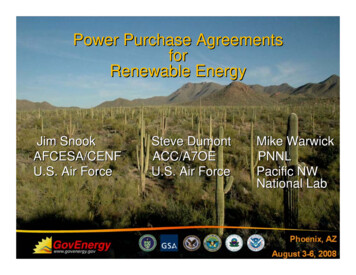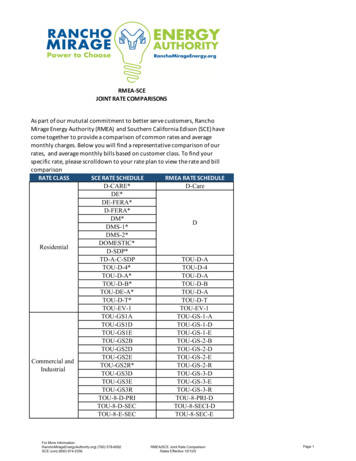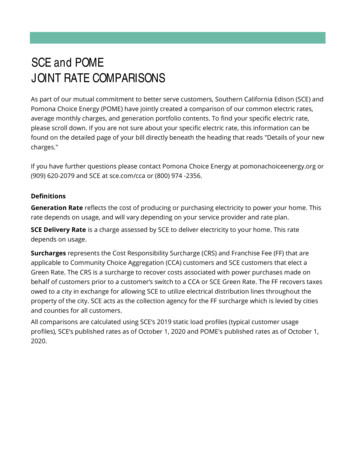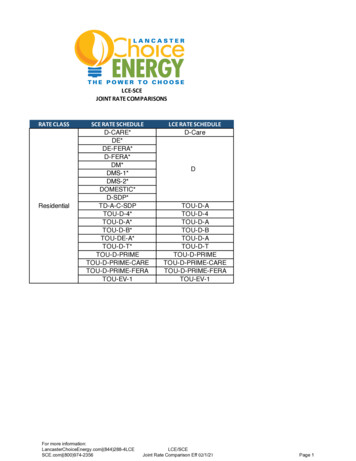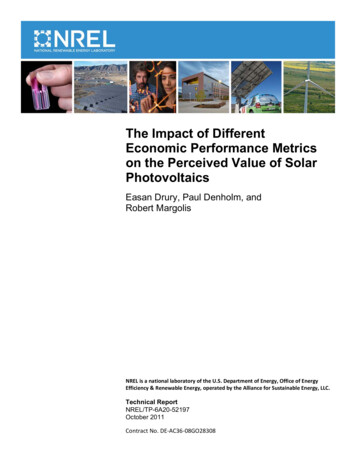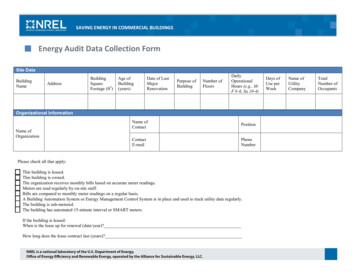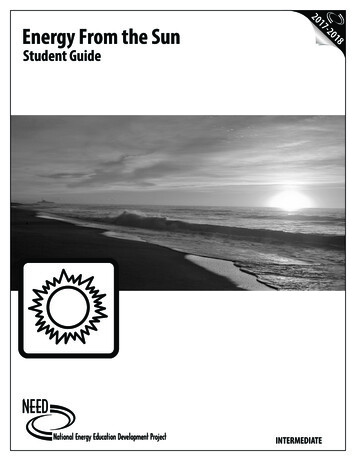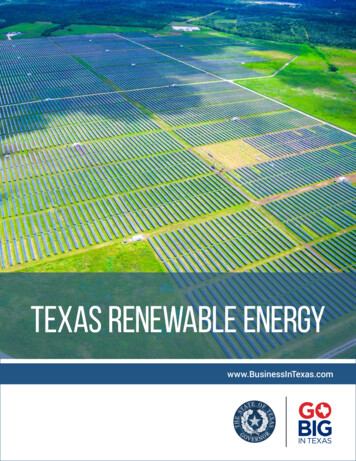
Transcription
Texas renewable energywww.BusinessInTexas.com
The TexasRenewable Energy Industry2014www.TexasWideOpenForBusiness.comOffice of the Governor Economic Development & Tourism
ContentsOverview . 1Wind Energy . . 2Solar Energy. . . 20Biofuels & Biomass. . . 25Key TermsThis report references a few technical terms to describe energy and power.Power is the rate at which electricity flows. Power is often measured ingigawatts (GW), which are equivalent to one thousand megawatts (MW).One MW is equal to 1,000 kilowatts (kW).One MW of electricity is enough to power roughly 300 homes at a typicalrate of usage. A single medium-sized wind turbine operating at full capacity can, on average, generate one MW.Energy is the total amount of electricity consumed over a period of time.Energy is often measured in megawatt-hours (MWh), which are equivalentto 1,000 kilowatt-hours (kWh). British thermal units (BTU) are also used tomeasure energy. One MWh is equal to 3.4 million BTU.Kilowatt-hours are the most commonly used billing units for electricity inthe United States (U.S.). A household appliance, such as an air conditioneror microwave, rated at 1 kW operating for one hour uses 1 kWh.
Texas Renewable Energy HeadlinesTexas ranks No. 1 in the nation for wind energycapacity and biodiesel productionSee Pages 13 & 26If Texas were a country, it wouldrank No. 6globally forinstalled windenergy capacitySouthern Power Company’sNacogdoches GeneratingFacility in Sacul, Texas, is thelargest biomass power plant inthe nationSee Page 12See Page 27Texas ranks #2nationally foremployment in therenewable energyindustryRBF’s Port NechesFacility, located inthe Houston area,is the nation’slargest biodieselproduction plantTexasA&M’sCenter for SolarEnergy will be theworld’s largestsolar PV R&Dfacility whencompleteSee Page 10See Page 26See Page 22CPS Energy is working on alandmark 400 MW solarproject in San Antonio that willbe the nation’s largest whencompleteSee Page 21Royal Dutch Shell relaunchesits Shell Technology Center inHouston with afocus on biomasssourced biofuelsSee Page 27
The Texas Energy IndustryBrazos Wind Farm, West TexasFor over a century, Texas has been an international leader in the oil and gas industry. Inrecent years, the state has built upon its energyexperience and trained workforce to take the lead inrenewable energy production and services. As a result,Texas has become the top state in wind generationcapacity and biodiesel production.The Lone Star State’s energy potential is among thelargest in the nation, with abundant wind, solar, andbiomass resources found across the state’s geographically diverse regions.Ernst & Young ranked Texas No. 3 in the nation in itsU.S. Renewables Attractiveness Indices in August2013. A variety of factors are used to determine astate’s ranking, and in Texas’ case, relied primarily onwind and solar resources, followed by biomass andlastly geothermal resources.According to the U.S. Energy Information Administration (EIA), Texas is the leading state for overallenergy production and consumption. The state is alsothe leading producer, importer, andrefiner of oil and gas products.Texas ranks No.Innovation in the natural gas industry1 in the nationhas further solidified Texas’ role asfor wind energythe nation’s energy leader over thecapacity andpast few years. The energy industrybiodieselis an important part of the diverseproductionand growing Texas economy.Renewable energy is a vital component of Texas’ allof-the-above strategy for energy independence andleadership. Reliance on a single source of energy canthreaten energy security and heighten price volatility.Energy diversification across different sectors (fossilfuel, nuclear, and renewable) and geographies (highplains wind and coastal wind, for example) can helpmake Texas energy more robust and flexible. Adiverse energy portfolio can also better respond tochanging economic and geopolitical conditions.Texas Renewable Energy Consumption 2011The state has developed a strong foundation in thegrowing renewable energy industry. According toTexas Workforce Commission data, over 102,000Texans are directly employed in renewable energysectors, and thousands more work in industries closelytied to the renewable energy industry. Texas’ businessclimate encourages renewable technology innovationand commercialization, and the state is home toleading research institutions working in renewableenergy industry areas.Source: U.S. Energy Information Administration1
OVERVIEWKey TexasRenewable Energy RankingsNo. 1 in wind energy capacityNo. 1 in wind energy-related manufacturingTexas Attracts Renewable EnergyInvestment from around the WorldSelected foreign companies withrenewable energy operations in Texas:No. 1 in wind industry employmentChinaNo. 2 in total renewable energy employmentGrowatt: HoustonNo. 1 in biodiesel productionFranceNo. 1 in solar potentialAlstom: Amarillo, Lubbock, etc.No. 6 in solar energy industry employmentEDF Energies Nouvelles:Statewide (wind farms)No. 4 for clean energy-related patentsGermanyE.On: Austin, statewide (windfarms)Top 5 Texas-Based Companies withRenewable Energy OperationsSemiconductor/PVproductsHQ: DallasSemiconductors/invertersHQ: Austin100% renewableenergy utilityHQ: AustinKako new energy GmbH:San AntonioItalyEnel S.p.A.: HermleighThe NetherlandsRoyal Dutch Shell: Houston,statewide (wind farms)South KoreaOCI Solar Power: San AntonioSamsung: AustinSpainGamesa: Statewide (wind farms)Ethanol productionHQ: PlanoEnergia ERCAM: San AntonioUtility operatinglandfill gas sitesHQ: HoustonUnited KingdomIberdrola: Statewide (windfarms)BP: Houston, statewide (windfarms)RES Ltd: Statewide (wind farms)2
OVERVIEWRenewable Energy in TexasWhile renewable energy has a relatively small impacton energy consumption in Texas, its share is growingrapidly. Renewable sources accounted for 4.1% of allenergy consumed in Texas in 2011, according to theEIA. This ratio has increased substantially over thepast decade as renewable energy sources haveexpanded, while total statewide energy consumptionhas remained steady over the past 15years.Wind energyaccounts for76% of Texas’renewableenergyconsumptionWind gener ation in the state wastwelve times larger in 2011 than 2002,and wind’s share of the Texas Interconnection Region’s electric powergeneration was 19.7% at the end ofDecember 2013. Wind energy nowcomprises over three quarters ofTexas’ renewable energy usage, followed by biofuelsand biomass (see chart on page 1).The 2000s was the decade wind accelerated in Texas,and solar deployment has the potential to be similarlymeteoric over the current decade. According toERCOT, statewide solar generation increased 265%from 2011 to 2012 alone, from36,580 MWh to 133,642 MWh.Biomass andTexas currently ranks No. 6biofuels accountnationally in installed solar photofor 36% of Texas’voltaic PV capacity.renewable energyconsumptionThe strength of the Texas biomassand biofuels industr y lies in thestate’s natural resources, skilled workforce, andexisting petroleum-based infrastructure. More biodiesel is made in Texas than in any other state, andbiomass facilities harvest usable energy from landfills,wastewater, and byproducts of forestry, livestock, andagriculture across the state. Biomass and biofuelsaccount for 36% of Texas’ renewable energy consumption.Texas also has small amounts of renewable energyresources from geothermal and hydroelectricity.Altogether, these account for less than 3% of thestate’s total renewable energy portfolio.Energy Consumption(Trillion BTU)Texas Renewable Energy Growth 1985-2011400300200All Renewable10001985Wind19901995200020052010Source: U.S. Energy Information Administration3
OVERVIEWThe Texas Electric GridIn the continental United States, the electricity systemconsists of three regions, the Eastern Interconnection,the Western Interconnection, and the Texas Interconnection. The latter, operated by the Electric ReliabilityCouncil of Texas (ERCOT), is separatefrom the rest of the nation, makingTexas is theTexas the only mainland state with itsonly state inthe lower 48 own grid. As a result, the utilities withinERCOT are exempt from most federalwith its ownregulation.power gridERCOT is a membership-based, nonprofit corporation whose members include electricutilities, generators, and transmission providers. Theorganization works to ensure generation, transmission,and frequency regulation services are available tomeet the state’s energy needs. ERCOT is subject tooversight by the Public Utility Commission of Texas(PUC), a state agency responsible for monitoring theelectric and telecommunications industries in the state.2013 ERCOT Generation by Fuel TypeSPP: Southwest Power PoolSERC: Southeast Electric Reliability CouncilWECC: Western Electricity CoordinatingCouncilSource: PUCERCOT’s Texas Interconnection Region covers 75%of the state’s landmass and 85% of the electrical load(see map above). The 23 million Texans within theERCOT region consumed 331,624 gigawatt-hours(GWh) of electricity in 2013, including32,705 GWh from wind.In 2013, around 78% of the state’sgenerated power came from fossil fuels(natural gas and coal). Nuclear was nextwith 11.6% while wind generation hasgrown to almost 10% (see chart at left).Wind energyaccounts fornearly 10% ofTexas’ energyproductionIn 1999, the Texas Legislature restructured the state’selectric industry and allowed consumers to beginchoosing their Retail Electricity Provider (REP). In2002, the law was enacted, thus deregulating theTexas electricity market. Deregulation has fosteredcompetition among REPs, driving down costs andimproving service. Deregulation also allows somecustomers to select and receive renewable energy. Atleast 26 REPs in Texas offer a 100% renewable planto their customers as an option.Source: ERCOT4
OVERVIEWTexas Emerging Technology FundRenewable Energy-Related AwardsRecipient21-Century SiliconRenewable Portfolio StandardAdopted in 1999, the Texas Renewable PortfolioStandard (RPS) required 2,000 MW of new renewableenergy capacity to be installed statewide by 2009. In2005, the Texas Legislature extendedthe RPS to expand the state's generatTexas reacheding capacity from renewable energyits renewablesources to 5,880 MW by 2015 andenergy targetincluded a target of 10,000 MW by15 years early2025, with 500 MW coming from non-wind sources. The state’s installedcapacity reached the 10,000 MW target in early 2010,15 years ahead of schedule.The Texas legislation also established requirementsfor electric utilities and other REPs to serve a specified amount of customer demand with sources ofrenewable electricity. Although thirty eight states nowhave RPS laws in place, the Texas RPS remains oneof the most effective and successful in the nation.ActaCellAlgae Bio Fuels ConsortiumBetaBattSectorAwardPolysilicon 3,500,000Energy Storage 1,000,000Research 4,025,000Energy Storage 500,000Ctr. for Commercializationof Electric TechnologiesResearch 500,000EQMABiomass 250,000Faradox Energy StorageEnergy Storage 1,000,000Ideal Power ConvertersInverters 1,000,000Electric Motors 2,800,000KLD Energy TechnologiesLynntechBatteries 600,000National Wind ResourceCtr.Research 8,400,000Smart Grid 1,500,000Algae Biofuels 1,000,000SolarBridge TechnologiesInverters 1,500,000SolarnoSolar Cells 1,000,000OptiSensePhoton8Sunrise Ridge AlgaeAlgae Biofuels 250,000Superconductivity AppliedResearch HubResearch 3,675,000TerrabonBiomass 2,750,000In 2003, the Texas Legislature authorized the 295million Texas Enterprise Fund (TEF), a “deal closing”fund created to attract businesses and new jobs toTexas. The TEF was reauthorized most recently in2013. Through this fund, the state has invested over 4.7 million in renewable energy-related projects thatare expected to create over 270 jobs.Texas A&M Wind EnergyCenterResearch 2,200,000Texas BioEnergy AllianceResearch 3,412,500The Texas Emerging Technology Fund (TETF) wascreated by the Texas Legislature in 2005 to provideTexas with an advantage in the research, development,and commercialization of emerging technologies. TheTETF was reauthorized most recently in 2013. Todate, the TETF has awarded over 46 million torenewable energy-related projects, spanning technologies such as solar cells, algae biofuels, and advancedbatteries. These investments are intended to createBusiness Incentives5Texas MicropowerEnergy Capture 750,000Turbo Trac USAPowerTransmissions 2,000,000TXL GroupEnergy Capture 500,000Xtreme PowerEnergy Storage 2,000,000TOTAL 46,112,500long-term economic benefits to the state throughinvestments in early-stage technology companies,regional innovation centers, and academic researchrecruitment. See the table above for more information.
OVERVIEWRenewables Franchise Tax DeductionCompanies solely engaged in manufacturing, selling, or installing solar or wind devices are exemptfrom the Texas franchise tax. Other businessesthat install solar or wind energy systems are eligible for a franchise tax deduction of 10% of thesystem’s cost.Renewables Property Tax ExemptionResidential, commercial, and industrial renewableenergy devices are exempt from property taxunder Texas law. This exemption is applicable tomost renewable technologies, including solar,wind, and biomass.Outlook for TexasRenewable EnergyWhile renewable energy has grown rapidly in Texas,the industry is stillevolving.Mostrenewable technologiesare not yet pricecompetitivewithtraditional fossil fuelgeneration. The recentextraordinary growthin shale gas recoverytechnologydrovenatural gas prices torecord lows throughoutmost of 2013 andwidened the gap forrenewable energy toachieve cost parity.to continue. The success of the state’s RPS and windindustry has led to emerging constraints in transmission capacity. Texas wind resources are greatest inWest Texas, while the majority of the population andpower demand lies in the eastern half of the state.Furthermore, West Texas wind blows hardest at nightwhen energy demand and prices are low.In response to these challenges, the PUC collaboratedwith ERCOT to establish the Competitive RenewableEnergy Zone (CREZ) tr ansmission pr oject in WestTexas (see details on page 7). Completed in 2013, the 6.9 billion CREZ transmission project relievesstatewide east-west congestion and transmits 18.5MW of windpower to the more populous areas ofTexas. The new transmission lines will enable Texasto provide three times as much available wind poweras any other state.In addition to infrastructure projects, emergingtechnologies can provide cost effective ways tomaximize the state’s energy assets as patterns ofCREZ TransmissionLine RoutesAs renewable energygeneration continues toadvance, the electricinfrastructuremustadapt to allow growthSource: Texas State Energy Conservation Office6
OVERVIEWgeneration and transmission change. Emergingtechnologies may provide cost effective ways tomaximize the state’s energy assets as patterns ofgeneration and transmission change. Under demandresponse management, par ticipating consumer sagree to reduce or modify electricity use when thegrid’s capacity is stressed. Incentives are available toparticipating large electricity users in the ERCOTmarket to compensate for the reductions.critical to energy storage project developers inERCOT territory, where transmission utilities areresponsible for the cost of interconnection, not projectdevelopers. Regulatory hurdles are also being cleared.In March 2012, the PUC adopted a set of rulesallowing energy storage facilities to buy and sellelectricity at wholesale rates, in order to competitivelyservice the grid as dispatchable plants for bothancillary services and longer term energy storage.Utility-scale energy storage technology is beingadapted in Texas to mitigate intermittency by absorbing short-term fluctuations in renewables output sothat customers can receive reliable electric service.Energy storage systems also store excess energy forlater use when demand is higher. There are a widevariety of energy storage technologies currently in useor undergoing research.Demand response, energy storage, and many othergrid management tools rely on smart grid technologyto enable their effectiveness. Smart grid technologyenables far-flung facilities on the grid to communicateand coordinate actions with one another. According tothe GridWise Alliance and Smart Grid Policy Center,Texas is tied with California as the top-ranked statesfor smart meter deployment. Texas’ deregulated andcompetitive energy markets allow retail powerproviders to use those assets to increase customerpricing programs and engagement efforts, while thathasn’t happened as quickly in California’s regulatedutility environment.In 2011, the Texas Energy Storage Association(TESA) helped pass a bill to clarify that storageresources participating in the wholesale market havethe same rights as generators with regard to interconnection and transmission access. This law, SB 943, isCompleted CREZ Infrastructure and Smart Grid TechnologyDeliver Texas’ Wind EnergyIn March 2012, ERCOT implemented its new Transient Stability Analysis Tool, which helps manage the flow ofelectricity across the state in real time. This smart grid technology helps ERCOT maximize the potential windgeneration capacity in the state.In December 2013, the last portion of the 3,600 miles of the CREZ transmission lines project, which was primarily designed to move windenergy resources from West toEast Texas, was completed.Together, the CREZ infrastructure and smart grid technologyassure the maximum use ofwind generated energy, whichis delivered to the ERCOT service areas that need it the most.Source: Cross Texas Transmission7
OVERVIEWResearch & DevelopmentTexas businesses and institutions are key drivers ofU.S. research and development activity in the renewable energy sector. Texas ranked No. 4 in the nation inclean energy-related patents with102 in 2012, according to intellecTexas ranks No. 4nationally for clean tual property law firm HRFM.Additionally, Texas ranks No. 4 inenergy-relatedthe nation for overall venturepatents issuedcapital investment in 2013,according to the National VentureCapital Association. Energy (NVCA). Energy andbiotech deals accounted for a substantial amounts ofthe state’s investments.The Austin Technology Incubator (ATI) at the IC2Institute at the University of Texas at Austin (UTAustin) is home to ATI’s CleanEnergy Incubator (CEI). One ofthe businesses currently at theCEI is ActaCell, an early stagelithium-ion battery technology company in which theTETF has invested.The San Antonio Clean Energy Incubator (SACEI)opened its doors in 2011 to foster business activity inthe renewable energy sector. SACEI is a part of theUniversity of Texas at San Antonio’s (UTSA)SustainableEnergyResearchInstitute(SERI), which played arole in developing a rooftop solar array at UTSA forresearch and demonstration purposes. SERI wascreated in 2010 with a 50 million donation from theCity-owned utility, CPS Energy. The Institute isdevoted to investigating sustainable energy technologies, including renewable energy.Established in 2009, Pecan Street Inc. is a researchand development organization affiliatedwith UT-Austin. The organization takes amultifaceted approach to clean energywith a smart grid demonstration project, aresearch consortium involving several Fortune 500companies, and a technology commercialization lab.The interdisciplinary Energy Institute at UT-Austinwas founded in 2009 to focus university research onenergy storage, carbon capture and storage, artificialphotosynthesis, and other energy technologies. Onerecent carbon-based nanotechnologyproject at the institute investigatedactivated graphene supercapacitors, afast-dischargingenergystoragedevice.The Richard E. Smalley Institute for NanoscaleScience and Technology at Rice University pioneers wide-ranging research and commercializationefforts in nanotechnology, including those with energyapplications. One such nanotechinnovation is a quantum wirecapable of transmitting electricityacross long distances withoutsuffering transmission losses.Texas A&M University’s Advanced ResearchInitiative for Sustainable Energy(ARISE) ser ves as a focal point forscientific research activities throughout theUniversity in the renewable energy field.The University of North Texas’s (UNT) Zero Energy(ZØE) Research Laboratory r esear ches and testsalternative energy generation technologies, including solar, wind, and geothermal energy.Since its founding in 1999, the Houston TechnologyCenter (HTC) has suppor ted over300 early stage technology businesses,including companies in the renewableenergy sector.8
OVERVIEWMajor CompaniesLeading Renewable Energy Companies with Operations in TexasPrimaryLocation(s)Company NameTypeDetailsRoyal Dutch ShellHouston,StatewideBiofuels,WindShell Wind Energy Inc. HQ and biofuelspilot plant in Houston, 2 wind farms in thestateBP plcHouston,StatewideWind,BiofuelsBP Alternative Energy division HQ inHouston, 4 wind farms in the stateSamsung AustinSemiconductorAustinSolarSemiconductors/PV productsE.ON Climate &Renewables, N.A.StatewideWind10 wind farms in the stateEDF Energies Nouvelles StatewideWind5 wind farms in the stateAlstom WindWindWind nacelles manufacturerDuke EnergyEDP Renewables N.A.AmarilloSan Antonio,West TexasHouston,StatewideWind, SolarWind5 wind farms in the state and one solarfarm in San AntonioOperates 2 wind farms in Texas, NorthAmerican HQ in HoustonNextEra EnergyStatewideWind9 wind farms in the stateTexas InstrumentsDallas,Richardson, etc.SolarSemiconductors/PV ctors/InvertersSunEdisonPasadena,StatewideSolar2 solar plants in the state, MEMC SunEdison manufactures granular polysilicon inPasadenaMaxim IntegratedProductsTECO-WestinghouseMotor CompanyAustin, Dallas,San AntonioSolarSemiconductors/InvertersRound RockWindWind turbine manufacturerKACO new energySan AntonioSolarPV invertersWindWindmill blades manufacturerMFG Wind (MFG EnergyGainesvilleServices)RES-AmericasAustin, Statewide Wind, Solar13 wind farms in the state and onesolar farm near AustinWhite EnergyDallas, Hereford,BiofuelsPlainviewLargest ethanol producer in TexasSources: Company websites, D&B9By ultimate parent revenues, representative sample only
OVERVIEWTexas Ranks No. 2 in the U.S. inRenewable Energy EmploymentEmploymentCaliforniaTexas ranks No. 2 nationally with over 28,000renewable energy workers, according to the latestinformation from the Clean Jobs Index. These jobsspan a number of industries, from wind turbinemaintenance to semiconductor manufacturing.53,431Texas28,040New YorkJob growth in the renewable energy industry isexpected to remain strong over the next decade.According to a report by the Cynthia and GeorgeMitchell Foundation, the expanding wind and solarenergy industries are projected to add 6,000 jobs inTexas per year through ource: Clean Jobs Index, Ecotech Institute, 2012 dataMore than 1,300 Texas companies employ around102,000 workers in industries directly and indirectlyrelated to renewable energy, according to TexasWorkforce Commission data. These workers arehighly skilled and well paid, earning an averageannual salary of 78,257, which is 85% above thestate average. The table below shows employmentstatistics for selected industry areas related to renewable energy.Texas’ experience in energy runs deep. In addition toabundant natural resources, the state’s workforcecluster has decades of experience in energy-relatedland and project development, industrial scalability,and energy trading. While most of this know-howdeveloped in traditional energy sectors, in recent yearsthe state’s energy industry has applied its knowledgeto the expanding renewable energy fields.Renewable Energy-Related Employment in TexasSecond Quarter 2013FirmsEmployeesAverageAnnual WageElectric Power Generation (22111)-Wind Electric Power Generation (221115)1031712,087833 98,228 114,920Electric Power Transmission, Control, & Distribution (22112)21731,393 88,140Power Line and Related Structures Construction (23713)68918,426 58,760Turbine & Power Transmission Equipment Mfg. (333611)231,249 77,220Semiconductors, Solar Cells, and Related Devices Mfg. (334413)12528,775 114,920Electrical Equipment, Generator Mfg. (33531)1889,595 66,560Battery Mfg. (33591)12276 69,0041,374102,634 78,257Sector(Industry Code)TOTALSSource: Texas Workforce Commission10
OVERVIEWTraining InitiativesTexas universities, community colleges, and industrycertification programs are continuously developing andexpanding renewable energy course offerings. The Environmental Defense Fund’s Texas Green Jobs Guidebookidentifies over 50 Texas community colleges that offer anarray of low-cost programs to prepare students for greenjobs.The Texas Higher Education Coordinating Board estimatesthat over 28,500 renewable energy-related degrees wereawarded at Texas public institutions from 2009 to 2013(see chart below). Detailed sector-specific training initiatives are discussed in the wind, solar, and biofuels sectionsof this report.The Texas Renewable Energy Education Consortium(TREEC) is a gr oup of twelve statewide Texas collegesdevoted to educating Texas’s renewable energy workforce.From Amarillo to Harlingen, the consortiumworks to offer degrees, certificates, professional development, and technical training. TREECcourses are offered in wind, solar, energyefficient building design, and fuel cells.Wind energy program student at Texas State TechnicalCollege (TSTC), a TREEC member. Photo courtesy of TSTCRenewable Energy-Related Degrees Awarded in Texas, 2009-2013All Texas Public Institutions, All Degree LevelsElectrical Engineering7,391Computer Science6,786Mechanical Engineering6,479Engineering Technicians*4,406Chemical Engineering2,260Computer Engineering1,227TOTALTOTAL*Includes electrical, industrial, manufacturing, and mechanical technicians1128,54928,549Source: Texas Higher Education Coordinating Board
Wind Resources in Texas and the U.S.Desert Sky Wind Farm, West TexasWind is a clean, affordable, and renewableenergy resource which plays a significantand growing role in the U.S. and Texasenergy markets. According to the Wind EnergyFoundation, wind is currently the fastest growingsource of electricity production globally. Windgeneration technology is mature and proven, andincreasingly cost competitive. Texas is the leadingstate for wind energy generation, with over 20% of thenation’s installed wind capacity. If Texas were acountry, it would rank sixth in installed capacity.Wind generation has proven popular because it ischeaper than solar, requires no water or other scarceresources, and emits no greenhouse gases. Sincewindmills must be spaced out to maximize theirWind Power Capacity by Place2012Country/StateInstalledCapacity (MW)1China75,2342United 6Texas12,214Source: U.S. National Renewable Energy Laboratoryefficiency, much of the underlying land can still beused for its original purposes, such as agriculture andlivestock production.Because of wind power’s cost and efficiency advantages, wind installations far outpace solar. Adecade after surpassing solar production, U.S. windgeneration is ten times greater than solar generation,according to the EIA.Texas’ world-class wind industrycomes from its abundant naturalIf Texas were awind resources. With plentifulnation, it wouldwind on the Great Plains andrank No. 6 globallyalong the Gulf Coast, the statefor installed windranks first nationally for windpower capacitygeneration potential, according tothe American Wind EnergyAssociation (AWEA). The state’s Renewable Portfolio Standard, enacted in 1999, also played a major rolein encouraging wind energy development in Texas.Sources: Global Wind Energy Council, American Wind Energy Association12
OVERVIEWInstalled Wind Generation Capacity 2012Texas is by far the leading state inwind energy generation with 12,214megawatts (MW) of installed capacity— enough to powerTexas ranks No. 1 over 3.3 millionhomes.Windnationally forcapacity in Texas iswind energyinstalled capacity 45% greater than inCalifornia,thesecond-ranked state.The Texas wind industry has seen atremendous boom since the first commercial windfarm was built in 1995, and by 2012, 116 windprojects were operational in Texas, according toAWEA. The wind industry employs over 10,000 inTexas, and six of the nation’s ten largest wind energygeneration projects are located in the state, accordingto AWEA (see chart on page 14).Source: American Wind Energy AssociationThe area with the greatest wind potential in the U.S. isthe Great Plains, which stretches from Texas to NorthDakota. The PUC reports that Texas’ wind powerpotential is almost double the state’s total annual peakelectric demand and could therefore meet the full needof consumers if fully harnessed.The vast majority of Texas’ wind generation capacityhas been installed within ERCOT’s territory. Of thiscapacity, 70% is located in West Texas, with anadditional 22% along the Gulf Coast and the remaining 8% in the northern region. The CREZ transmission lines, completed in 2013, now facilitate the movement of wind power fromERCOT Annual Wind Power Generation in TexasWest Texas to more populated areas to the35,000east. In May 2013, wind accounted for arecord 9,674 MW or 28% of all energygenerated in ERCOT’s operating region, up25,000from 9.2% in 2012.In 2007, Texas became the first state to reach themilestone of one gigawatt of wind capacity installedin a single year. In 2012 alone, the state added 1,826MW of wind generating capacity.Texas Wind Farms15,0005,00002003Source: ERCOT1320052007200920112013The state’s largest cluster of wind farms islocated in West Texas, where Taylor,Nolan, Scurry, and Sterling countiescollectively account for about 33% of thestate’s total instal
Wind generation in the state was twelve times larger in 2011 than 2002, and wind’s share of the Texas Inter-connection Region’s electric power generation was 19.7% at the end of December 2013. Wind energy now comprises over three quarters of Texas’ renewable energy usage
